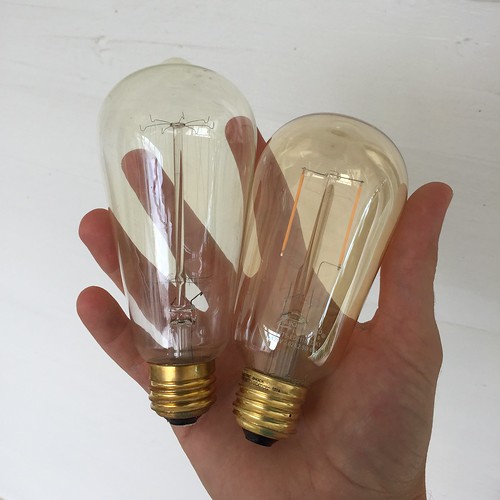Historic home renovation of any sort is a delicate balance between old and new.
Whether you're patching a hole in a 100 plus year old plaster wall or looking for period hardware or accessories that are both functional and appropriate in an old home, you have to weigh the character of the old against the function of the new. This has been true with everything from the advent of plumbing and electricity, to telephones, to modern HVAC, to Internet, etc. With the recent advances in technology related to eco friendly and cost effective alternatives to traditional home elements, this challenge of staying true to your home's roots while still embracing modern conveniences has never been more apparent.
Recently we discussed the new barn inspired lights we installed at the front door of our new house. We wanted something that looks appropriate and authentic for the home, and I think we achieved our goal. But the exposed bulb also had to look appropriate, otherwise we lose the whole look.
Initially we chose to use an historic looking filament "Edison" style bulb for the lights. We felt that the look of the bulb was as important as anything, so we were prepared to sacrifice the energy efficiency of a modern CFL or LED bulb for the style and warm light given off by these historically inspired bulbs.
for the lights. We felt that the look of the bulb was as important as anything, so we were prepared to sacrifice the energy efficiency of a modern CFL or LED bulb for the style and warm light given off by these historically inspired bulbs.
Begrudgingly accepting of our decision, I soldiered on, until a commenter on our blog post discussing our approach pointed out the availability of LED style filament bulbs. They directed me to the website, EarthLED.com. What I found was a treasure trove of light bulbs that would make the most ardently historic house nerds and eco friendly hipsters swoon with delight.
Their selection of filament style LED bulbs runs the gamut. From classic bulbs to candelabras they have offerings in all shapes and sizes from a huge variety of vendors. I was instantly intrigued and had to give it a shot. We had been running two 40 watt Edison style bulbs in the lights, so I looked for a comparable replacement in both shape, size and equivalent wattage.
When they arrived I was oddly giddy to try them out. The brand I opted for was from a company called Archipelago and the box outlined the expected energy usage and life expectancy of the bulb.
This is an important factor in my decision to purchase these bulbs. These are our outdoor lights and will be on when the sun sets and turned off around midnight, so there will be a good amount of use in these lights, possibly 3-7 hours per day depending on the time of year. As a result, we'll likely see a pretty significant overall reduction in cost, and we also likely won't ever need to replace these bulbs (unless we have the house for 30 plus years).
Comparing the two bulbs you can see they are essentially the same. The size and shape are very close, and the "filament" of the LED bulb on the right (the two yellowish strips) look very similar to the real filament of the traditional Edison bulb on the left.
So before we applied any electricity to actually generate light, they looked really good. But what would happen when we actually put them in place and flicked the switch? LED often has a higher than expected color temp, which means cooler light that often appears blue or green, rather than the traditional yellow orange of these old fashioned bulbs.
The color temp of these bulbs promised 2200K, very low and warm by bulb standards, and exactly what we wanted, but was it accurate? The moment of truth was upon us. After screwing in the bulb and turning on the lights, I was shocked at just how perfect this light looked. When illuminated the true filament bulb was almost indistinguishable from the LED Edison bulb!
To say I was happy with the bulb is an understatement. With one of each installed we took a step back and looked at the light and they were pretty much identical.
As the sun set it kept looking good. I'd even say the LED bulb light is a little warmer in person, which is exactly what we wanted. And to the touch, the LED bulb remains cool, where the filament bulb heats up almost immediately.
Deep down inside I've got a little hipster in me with my desire to make things look old and salvaged while also embracing the eco-friendly performance improvement that comes with these bulbs. (Hey, my hipster friend even told me that one of his hipster friends sent him a link to my salvaged rim lock restoration post, so I've got some street cred there.) So I'm super excited about using these bulbs in our house and plan to make our whole house as eco friendly and energy efficient as possible...one light bulb at a time.
Have you used any of these bulbs in your projects? If so, do you have a brand that works well for you? If not, do you think you have a place where you'll use them?

![]()
![]()